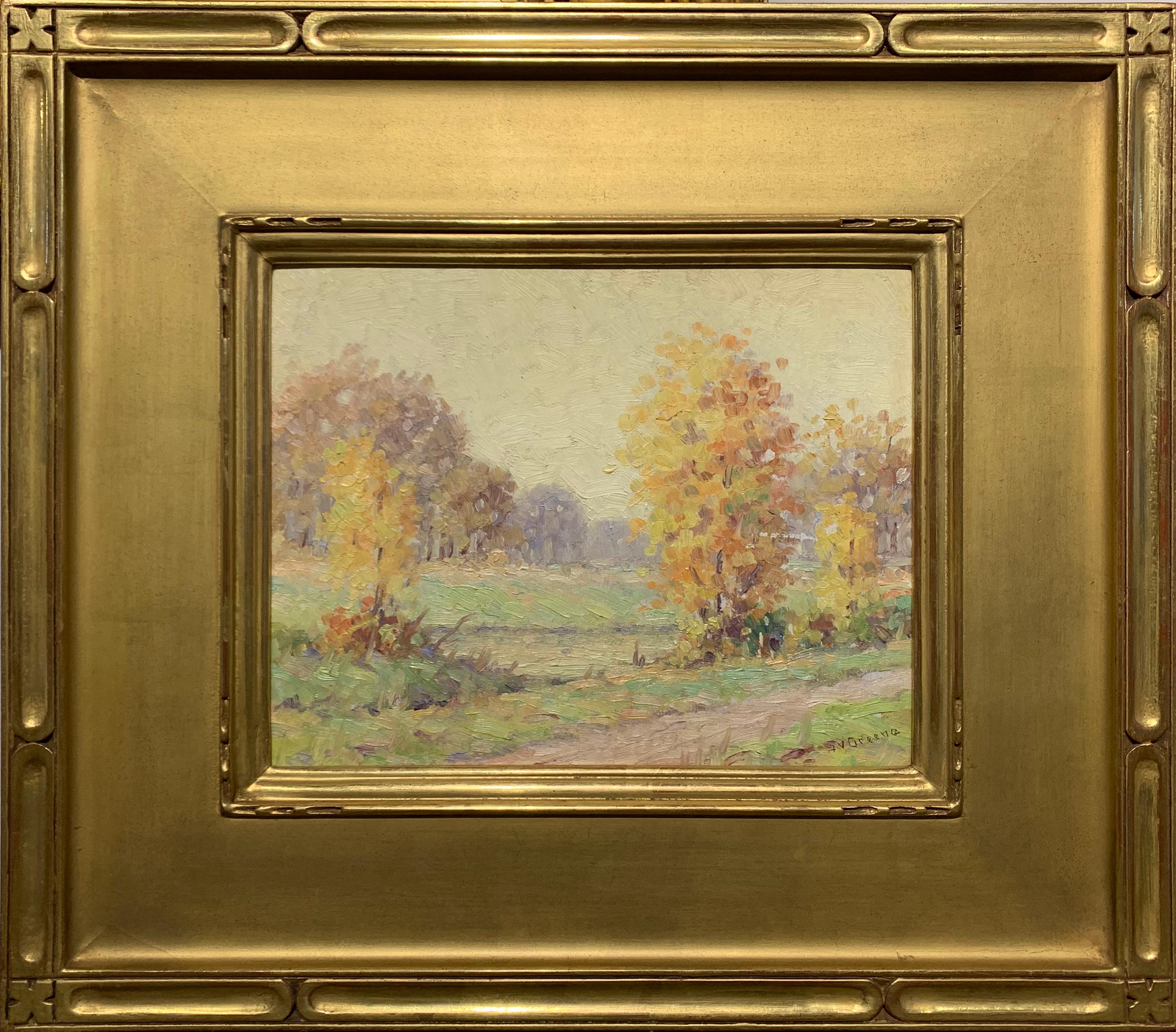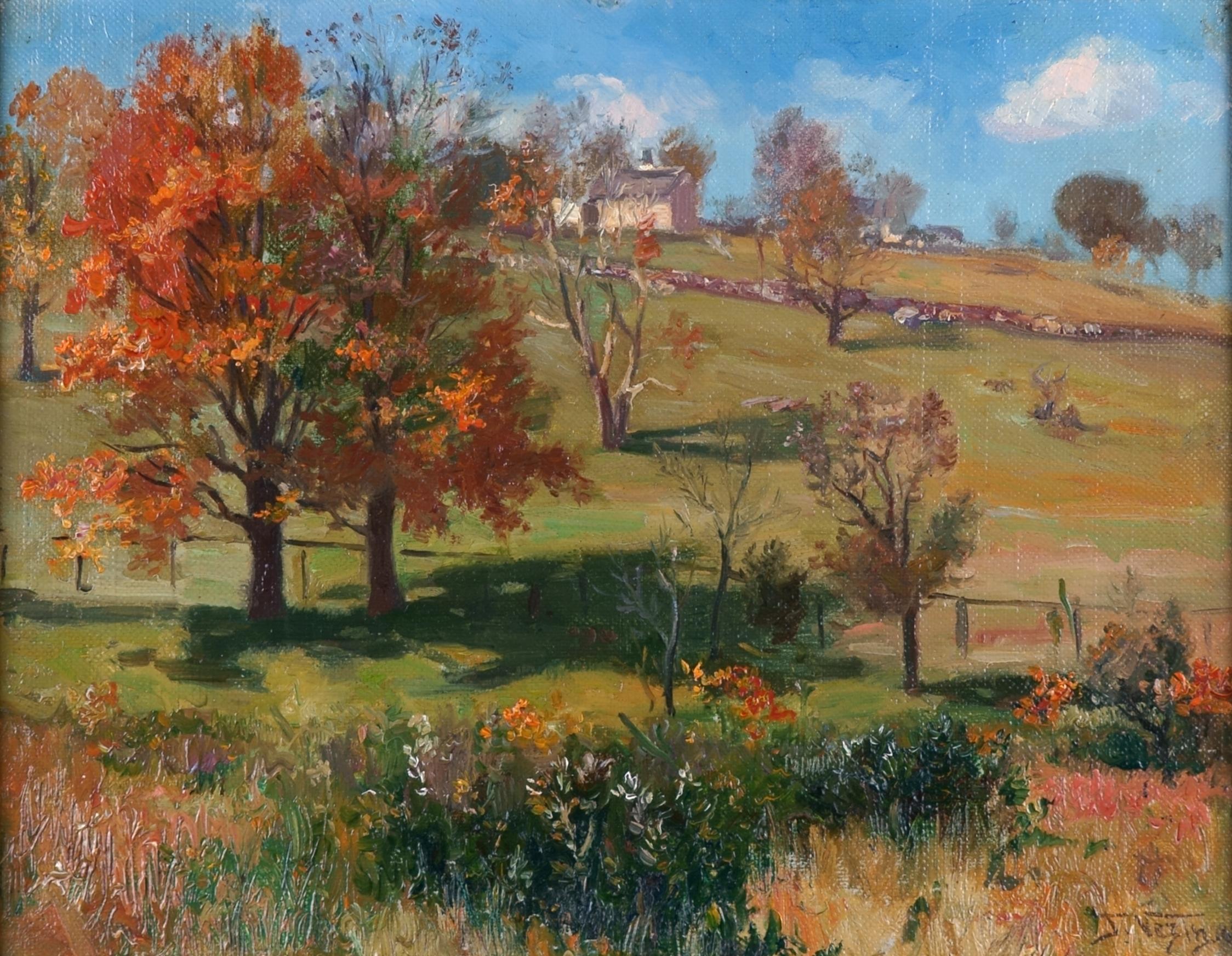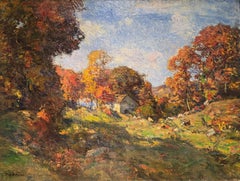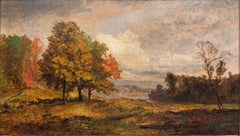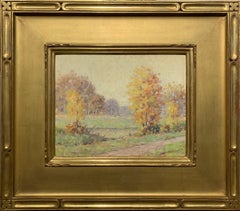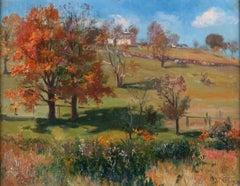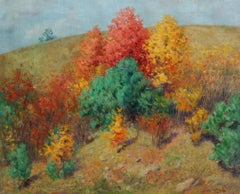Items Similar to "Autumn Landscape" Bruce Crane, Bright Orange, Luminous, Tonalist Fall Scene
Want more images or videos?
Request additional images or videos from the seller
1 of 7
Bruce Crane"Autumn Landscape" Bruce Crane, Bright Orange, Luminous, Tonalist Fall Scenecirca 1915
circa 1915
$15,000
£11,374.48
€13,160.80
CA$21,203.05
A$23,637.32
CHF 12,327.84
MX$285,830.01
NOK 154,966.94
SEK 146,629.69
DKK 98,231.94
About the Item
Bruce Crane
Autumn Landscape
Signed lower right
Oil on canvas
16 x 24 inches
Bruce Crane Was born in New York City, he studied with Alexander H. Wyant before attending the Art Students League from 1878-82. In addition to the New York mountains, the pastoral settings of East Hampton, Long Island, and New Jersey also provided material for Crane's poetic works. In his day, Bruce Crane was celebrated as one of America’s foremost landscape painters. Bruce Crane is best known for his golden Tonalist landscapes of the lowlands between the Adirondack and Catskill Mountains.
Crane's paintings are in the collections of the Metropolitan Museum of Art, Phoenix Art Museum, The Addison Gallery of American Art, Phillips Academy, Andover; Butler Institute of American Art, Youngstown; Chrysler Museum of Art, Norfolk; Denver Art Museum; Hunter Museum of American Art, Chattanooga;
- Creator:Bruce Crane (1857-1937, American)
- Creation Year:circa 1915
- Dimensions:Height: 24 in (60.96 cm)Width: 31.5 in (80.01 cm)
- More Editions & Sizes:Unique workPrice: $15,000
- Medium:
- Movement & Style:
- Period:
- Condition:
- Gallery Location:New York, NY
- Reference Number:1stDibs: LU1841216087792
Bruce Crane
Robert Bruce Crane was an American painter. He joined the Lyme Art Colony in the early 1900s. His most active period, though, came after 1920, when for more than a decade he did oil sketches of woods, meadows, and hills. He developed into a Tonalist painter under the influence of Jean-Charles Cazin at Grez-sur-Loing. Crane's mature works were nearly always fall and winter scenes. He usually painted in his studio in Bronxville, New York, where like many of the Tonalists he relied mostly on memories of his outdoor sketching experiences. Selected work can be found at the Florence Griswold Museum and the Newark Museum. He is a descendant of the Continental Congressman Stephen Crane.[1] Bruce Crane's father, Solomon Crane, was an amateur artist himself and interested his son in the New York art scene from a young age. However, it was a summer trip to the Adirondacks that piqued Bruce's interest in painting after witnessing “a lot of young lady amateur (artists.)” At the age of seventeen around 1874 he moved with his family to Elizabeth, New Jersey where he worked as a draftsman for an architect. In hopes of starting a career in this field, he approached the famous artist Alexander Wyant and asked to start an apprenticeship with him. Wyant asked to see some of Crane's work, but Bruce did not believe that his skills were adequate enough to impress Wyant. Therefore, he declined the request and spent the next year improving his skills before he showed his work to Wyant and began to work with him. They remained friends until Wyant's death. Bruce Crane began to then study at New York's Arts Student League and in 1876 he was featured for the first time in an exhibit at the National Academy of Design, submitting his painting called "Old Swedish Church, Philadelphia." Crane soon began to paint locations of East Hampton and Long Island, which brought him praise and critical approval, as well as a steady income. In 1909 he won a bronze medal at the Carnegie Institute exhibition for his work November Hills, showing that he was still a force to be reckoned with. Throughout the first two decades of the 20th century, Crane won at least 10 major national and international awards. This included the Inness Gold Medal (1901), Gold metal at the St. Louis Exposition (1904), The Saltus Medal (1912), and the silver medal at the Panama-Pacific Exhibition (1915). From 1929 to 1933, Bruce Crane was the President of the famed Salmagundi Club of New York City (founded 1871) and its artist of the year in 1902. He was also associated with the Grand Central Art Galleries, participating in its 1933 members' drawing. In 1897, he was elected into the National Academy of Design as an Associate Academician, and became a full Academician in 1901.
About the Seller
5.0
Platinum Seller
Premium sellers with a 4.7+ rating and 24-hour response times
Established in 2022
1stDibs seller since 2022
119 sales on 1stDibs
Typical response time: <1 hour
- ShippingRetrieving quote...Shipping from: New York, NY
- Return Policy
Authenticity Guarantee
In the unlikely event there’s an issue with an item’s authenticity, contact us within 1 year for a full refund. DetailsMoney-Back Guarantee
If your item is not as described, is damaged in transit, or does not arrive, contact us within 7 days for a full refund. Details24-Hour Cancellation
You have a 24-hour grace period in which to reconsider your purchase, with no questions asked.Vetted Professional Sellers
Our world-class sellers must adhere to strict standards for service and quality, maintaining the integrity of our listings.Price-Match Guarantee
If you find that a seller listed the same item for a lower price elsewhere, we’ll match it.Trusted Global Delivery
Our best-in-class carrier network provides specialized shipping options worldwide, including custom delivery.More From This Seller
View All"Autumn Landscape, " Bruce Crane, Tonalist American Impressionist Fall Scene
By Bruce Crane
Located in New York, NY
Bruce Crane (1857 - 1937)
Autumn Landscape
Oil on canvas
25 x 30 inches
Signed lower right
Robert Bruce Crane was an American painter. He joined the Lyme Art Colony in the early 190...
Category
Early 20th Century Tonalist Landscape Paintings
Materials
Canvas, Oil
"November" Bruce Crane, Tonalism Landscape Autumn Scene, American Impressionism
By Bruce Crane
Located in New York, NY
Bruce Crane (1857 - 1937)
November
Oil on canvas
25 x 30 inches
Signed lower right
Robert Bruce Crane was an American painter. He joined the Lyme Art Colony in the early 1900s. His ...
Category
Early 20th Century Tonalist Landscape Paintings
Materials
Canvas, Oil
"Autumn on the Farm" Charles Harold Davis, Fall Colors, Connecticut Hillscape
By Charles Harold Davis
Located in New York, NY
Charles Harold Davis
Autumn on the Farm, circa 1930s
Signed lower left
Oil on canvas
20 x 27 1/4 inches
Provenance
Private Collection, Florida
Charles Harold Davis was born in Ame...
Category
1910s American Impressionist Figurative Paintings
Materials
Canvas, Oil
"An Autumn Landscape" Jasper F. Cropsey, Hudson River School, Fall Landscape
By Jasper Francis Cropsey
Located in New York, NY
Jasper F. Cropsey
An Autumn Landscape
Signed and dated J.F. Cropsey 1898
Oil on canvas
14 x 24 inches
Provenance
Private Collection Texas, acquired in the early 1900s
Thence by desc...
Category
1890s Hudson River School Landscape Paintings
Materials
Canvas, Oil
"Autumn, New England" Charles Warren Eaton, Tonalist Gloaming Sunset in Woods
By Charles Warren Eaton
Located in New York, NY
Charles Warren Eaton
Autumn, New England
Signed lower right
Oil on canvas
30 x 36 inches
Provenance
Private Collection, Connecticut
A contemporary critic wrote that the paintings o...
Category
Early 1900s Tonalist Figurative Paintings
Materials
Canvas, Oil
"Stone Wall, Autumn, " George Smillie, Tonalist Fall Landscape View
By George Henry Smillie
Located in New York, NY
George Henry Smillie (1840 - 1921)
Stone Wall, Autumn, 1879
Oil on canvas
9 1/2 x 15 inches
Signed and dated lower right
Provenance:
Skinner, Boston, September 19, 2014, Lot 389
The career of George Smillie (1840-1921) followed the arc of nineteenth-century U.S. landscape painting. Trained in the Hudson River School tradition, Smillie successfully adapted to changing U.S. tastes and growing interest in European trends. In the late 1800s, he moved to tonalist paintings full of brushwork and influenced by French Barbizon painting. By the end of his career, he had lightened his palette to produce works similar to those of the U.S. impressionists. Yet in all styles, he was never less than competent, and his tonalist work is among the best produced in the United States.
Like many nineteenth-century painters, George Smillie’s artistic training began with the study of printing. His father, James Smillie...
Category
1870s Tonalist Landscape Paintings
Materials
Canvas, Oil
You May Also Like
Autumn on Canal, American Impressionist Landscape, Oil on Board, Signed
By Albert Van Nesse Greene
Located in Doylestown, PA
"Autumn on Canal" is a Pennsylvania landscape by American Impressionist painter Albert Van Nesse Greene.
The painting is a 8" x 10" oil on board, framed, and signed "A V Greene...
Category
Early 20th Century American Impressionist Landscape Paintings
Materials
Oil, Board
Autumn Landscape in Sunlight - Indian Summer -
Located in Berlin, DE
Frederick Vezin (1859 Torresdale Philadelphia - 1933 Düsseldorf), Autumn Landscape in the Sunlight, oil on canvas, mounted on cardboard, 32 x 41 cm (inside measurement), 44 x 51 cm (frame), signed and dates lower right "F. Vezin. [19]05".
- Cardboard slightly curved, small inconspicuous retouch at the centre of the upper edge of the picture.
About the artwork
Although the painting appears to be a sketch, Frederick Vezin considered it to be a finished work of art, as evidenced by his signature on the lower right. And it is precisely this sketchy quality that leads to an understanding of the painting, which was certainly created in the landscape itself: the natural phenomena were to be depicted artistically at the moment of their observation. This is not done by meticulously sketching nature, but - and here Vezin follows the teaching of French Impressionism - by illustrating nature in its visual fullness. The artist's eye is, as it were, immersed in the visuality of nature, which is made visible by his hand. The painting is therefore not a reflection of the landscape, but its artistic intensification.
This intensification also includes the fact that the foreground of the painting - corresponding to the field of vision - eludes a detail-oriented close-up view. Instead, the spatula-like application of paint, the vertical structure of which corresponds to the structure of the floral growth, has the effect of making nature tangible in its colourful substance.
At the same time, the foreground, which remains indeterminate in its concrete objectivity, creates an atmospheric space that connects with the actual protagonist of the picture, the group of trees, which flares up in shades of red and brown. Here, too, the leaves are more speckled than clearly outlined. It is precisely this 'sketchiness' that opens up a visual experience that makes the landscape accessible in its visual fullness, thus revealing its essence.
In addition to this abundance, the landscape is presented as a structure of order in that the composition of the picture makes the composition of the landscape visible. For example, the group of trees forms a distinct dark green shadow, which is repeated in the shadows cast by the trees behind it. A patterned diagonal axis is created in the picture, which is composed in this way by the landscape itself.
Strictly speaking, this is a cultivated landscape: a fence at the bottom and a low stone wall at the top, running from left to right, are two elements that also have a strong compositional effect. And on the top of the hill, a stone house is embedded in the landscape as the brightest surface in the picture. Nature and culture here form a harmonious synthesis, giving the painting an Arcadian touch.
In order to give the landscape as much space as possible, the horizon line is raised, but the design of the sky is also crucial. The clouds, combined with the shapes of the trees, create a bright blue sky. To the European eye, such a sky is reminiscent of a summer landscape. Accordingly, within the seasonal cycle, the blue sky is reserved for summer, and French Impressionism is also primarily an ode to summer. In Vezin's painting, however, the brilliant blue sky stands above an autumnal landscape, some of the trees even defoliated. It can therefore be assumed that the painting was made not in Europe but in the United States, and that it illustrates the proverbial Indian summer, making Frederick Vezin a pioneer of American landscape painting.
About the artist
Frederick Vezin was the son of a French immigrant to the United States and a German-born mother. This predestined him to promote artistic exchange between the old and new worlds. Having spent part of his schooling in Germany, in 1876, at the age of 20, he enrolled at the Düsseldorf Academy of Art, where he studied with Peter Janssen the Elder, Eduard von Gebhardt and Wilhelm Sohn, among others. He graduated in 1883, settled in Munich and returned to Düsseldorf in 1895, where he lived until his death in 1933.
A native of the United States, he travelled to the country frequently and became a popular portrait and society painter. His artistic talent, however, was most evident in his landscape paintings. Trained in French Impressionism, he developed a virtuoso use of colour and a free brushwork that remained tied to the landscape motif, opening up the landscape itself in a new way. Frederick Vezin turned his attention primarily to the landscape of his homeland, becoming a pioneer of modern American landscape...
Category
Early 1900s Impressionist Landscape Paintings
Materials
Cardboard, Oil
$2,087 Sale Price
20% Off
Autumn, 1923
By Bruce Crane
Located in Milford, NH
A splendid Autumn tonalist landscape by American artist Bruce (Robert Bruce) Crane (1857-1937). Crane was born in New York City, and as an artist, was influenced by the French Barbizon school of...
Category
1920s Tonalist Landscape Paintings
Materials
Canvas, Oil
Changing Leaves
By Joseph Varga
Located in Buffalo, NY
A beautiful antique impressionist painting by American artist Joseph Varga
Category
Early 1900s American Impressionist Landscape Paintings
Materials
Canvas, Oil
$1,800 Sale Price
25% Off
Autumn Landscape Painting by Carl W. Peters
By Carl Peters
Located in Rockport, MA
This painting by Carl W. Peters captures an autumn scene, featuring a rural village with houses, a horse-drawn cart, and townspeople engaging in daily life. The rich autumnal hues of...
Category
20th Century American Impressionist Landscape Paintings
Materials
Oil
Autumn II
By Samuel Hyde Harris
Located in Missouri, MO
By the great California Impressionist, Sam Hyde Harris.
Image Size: 12 x 16 inches
Framed Size: 14.25 x 18 inches
Signed and Titled Verso
At 14 years...
Category
1930s American Impressionist Landscape Paintings
Materials
Oil, Board
Price Upon Request
More Ways To Browse
Antique Crane
Autumn Mountains
Catskills Painting
Framed Cranes Painting
Paintings In The Adirondacks
Oil Paintings Cranes
Adirondack Oil Paintings
Phoenix Antique Frames
Alexander H Wyant
Elizabeth Taylor Painting
Horse Race Watercolor
Jean Gabriel Domergue
Jean Venetian
Oil Painting Girl With Dog
Olga Painting Acrylic
Peter Max Andy Warhol
Bill Hampton
Cheval Painting
